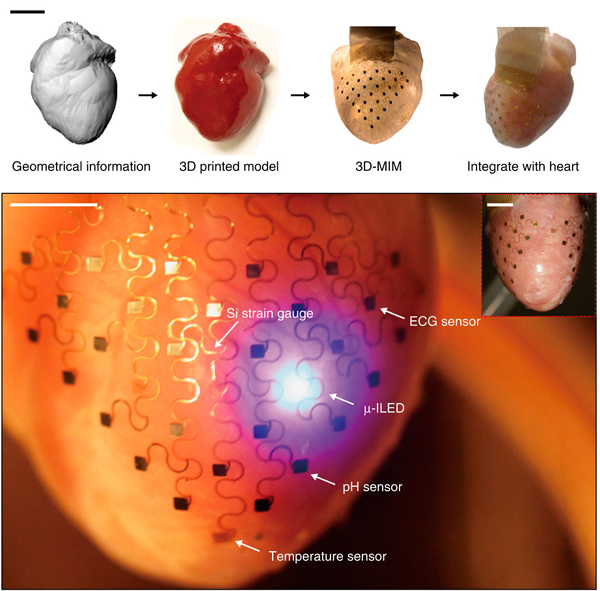Researchers Develop Multifunctional Membranes for Heart Health with 3D Printing

This 3D printed membranous sleeve fits perfectly around a heart, allowing for accurate monitoring. Courtesy of Rogers et al.
Latest News
March 4, 2014
Medical additive manufacturing (AM) has developed into its own field. It seems like not a day passes without medical researchers discovering a new way to use the technology to either save or improve lives. Whether its low-cost prosthetics, or medical implants, AM has brought a bevy of new options to health care.
New research has focused on combining 3D printing and heart health. In a paper titled “3D multifunctional integumentary membranes for spatiotemporal cardiac measurements and stimulation across the entire epicardium,” published in Nature Communications, a team of scientists describes the method they employed to create a membranous sleeve that can surround a heart to provide monitoring and cardiac assistance.

From the paper:
Here we create 3D elastic membranes shaped precisely to match the epicardium of the heart via the use of 3D printing, as a platform for deformable arrays of multifunctional sensors, electronic and optoelectronic components. Such integumentary devices completely envelop the heart, in a form-fitting manner, and possess inherent elasticity, providing a mechanically stable biotic/abiotic interface during normal cardiac cycles.
The procedure was tested using a rabbit’s heart. The research team first used information generated from medical data to produce a 3D image of the heart, then turned to AM to manufacture the elastic, silicon membrane that would surround the heart. The membrane contains a web of sensors to track heart activity.
Using 3D printing to build the membrane allowed the team to create a perfect fit for the heart, which helps ensure accurate monitoring. If the tests prove successful, the membrane could be fitted with additional electronics to assist patients suffering from rhythm disorders in the lower chambers of the heart, as well as the rhythm disorder atrial fibrillation.
In addition to aiding in heart monitoring, the technology could also be adapted to other organs, such as the kidneys, where it could be used to maintain a watch on ionic concentrations of calcium, potassium and sodium.
Regardless of where the sensor membrane ends up, the permanent nature of the implant would give doctors an easy way to monitor the health of their patients. Along with monitoring the heart for rhythm disorders, the sensor network could sense concentrations of troponin, which is an early indicator of potential heart attacks.
Below you’ll find an interesting video about the medical applications of AM.
Sources: LiveScience, Nature Communications
Subscribe to our FREE magazine, FREE email newsletters or both!
Latest News
About the Author
John NewmanJohn Newman is a Digital Engineering contributor who focuses on 3D printing. Contact him via [email protected] and read his posts on Rapid Ready Technology.
Follow DE





